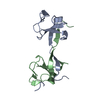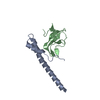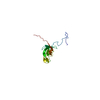[English] 日本語
 Yorodumi
Yorodumi- PDB-2hl3: Crystal structure of the A49M mutant CAP-Gly domain of human Dyna... -
+ Open data
Open data
- Basic information
Basic information
| Entry | Database: PDB / ID: 2hl3 | ||||||
|---|---|---|---|---|---|---|---|
| Title | Crystal structure of the A49M mutant CAP-Gly domain of human Dynactin-1 (p150-Glued) in complex with human EB1 C-terminal hexapeptide | ||||||
 Components Components |
| ||||||
 Keywords Keywords |  STRUCTURAL PROTEIN / STRUCTURAL PROTEIN /  microtubule binding / microtubule binding /  dynactin / cytoskeleton associated protein / p150Glued / EB1 / +TIP protein Complex structure / EEY/F-COO- sequence motif / CLIP-170 / alpha-tubulin dynactin / cytoskeleton associated protein / p150Glued / EB1 / +TIP protein Complex structure / EEY/F-COO- sequence motif / CLIP-170 / alpha-tubulin | ||||||
| Function / homology |  Function and homology information Function and homology informationpositive regulation of neuromuscular junction development / centriolar subdistal appendage / cell cortex region / protein localization to astral microtubule / cortical microtubule cytoskeleton / centriole-centriole cohesion / mitotic spindle astral microtubule end / ventral spinal cord development / microtubule anchoring at centrosome / maintenance of synapse structure ...positive regulation of neuromuscular junction development / centriolar subdistal appendage / cell cortex region / protein localization to astral microtubule / cortical microtubule cytoskeleton / centriole-centriole cohesion / mitotic spindle astral microtubule end / ventral spinal cord development / microtubule anchoring at centrosome / maintenance of synapse structure / melanosome transport / protein localization to microtubule / nuclear membrane disassembly / microtubule plus-end / positive regulation of microtubule nucleation / cell projection membrane / XBP1(S) activates chaperone genes /  dynein complex / attachment of mitotic spindle microtubules to kinetochore / COPI-independent Golgi-to-ER retrograde traffic / microtubule plus-end binding / non-motile cilium assembly / microtubule bundle formation / dynein complex / attachment of mitotic spindle microtubules to kinetochore / COPI-independent Golgi-to-ER retrograde traffic / microtubule plus-end binding / non-motile cilium assembly / microtubule bundle formation /  retrograde transport, endosome to Golgi / nuclear migration / protein localization to centrosome / microtubule associated complex / retrograde transport, endosome to Golgi / nuclear migration / protein localization to centrosome / microtubule associated complex /  motor behavior / motor behavior /  microtubule organizing center / neuromuscular process / negative regulation of microtubule polymerization / neuromuscular junction development / microtubule organizing center / neuromuscular process / negative regulation of microtubule polymerization / neuromuscular junction development /  intercellular bridge / mitotic spindle pole / cytoplasmic microtubule / cell leading edge / intercellular bridge / mitotic spindle pole / cytoplasmic microtubule / cell leading edge /  microtubule polymerization / establishment of mitotic spindle orientation / spindle assembly / regulation of microtubule polymerization or depolymerization / spindle midzone / Amplification of signal from unattached kinetochores via a MAD2 inhibitory signal / COPI-mediated anterograde transport / Mitotic Prometaphase / EML4 and NUDC in mitotic spindle formation / regulation of mitotic spindle organization / positive regulation of microtubule polymerization / Loss of Nlp from mitotic centrosomes / Loss of proteins required for interphase microtubule organization from the centrosome / Recruitment of mitotic centrosome proteins and complexes / Signaling by ALK fusions and activated point mutants / Resolution of Sister Chromatid Cohesion / Recruitment of NuMA to mitotic centrosomes / HSP90 chaperone cycle for steroid hormone receptors (SHR) in the presence of ligand / Anchoring of the basal body to the plasma membrane / MHC class II antigen presentation / microtubule polymerization / establishment of mitotic spindle orientation / spindle assembly / regulation of microtubule polymerization or depolymerization / spindle midzone / Amplification of signal from unattached kinetochores via a MAD2 inhibitory signal / COPI-mediated anterograde transport / Mitotic Prometaphase / EML4 and NUDC in mitotic spindle formation / regulation of mitotic spindle organization / positive regulation of microtubule polymerization / Loss of Nlp from mitotic centrosomes / Loss of proteins required for interphase microtubule organization from the centrosome / Recruitment of mitotic centrosome proteins and complexes / Signaling by ALK fusions and activated point mutants / Resolution of Sister Chromatid Cohesion / Recruitment of NuMA to mitotic centrosomes / HSP90 chaperone cycle for steroid hormone receptors (SHR) in the presence of ligand / Anchoring of the basal body to the plasma membrane / MHC class II antigen presentation /  centriole / neuron projection maintenance / centriole / neuron projection maintenance /  tubulin binding / AURKA Activation by TPX2 / ciliary basal body / RHO GTPases Activate Formins / tau protein binding / tubulin binding / AURKA Activation by TPX2 / ciliary basal body / RHO GTPases Activate Formins / tau protein binding /  protein localization / spindle / protein localization / spindle /  kinetochore / kinetochore /  mitotic spindle / mitotic spindle /  spindle pole / neuron cellular homeostasis / Separation of Sister Chromatids / The role of GTSE1 in G2/M progression after G2 checkpoint / microtubule cytoskeleton / spindle pole / neuron cellular homeostasis / Separation of Sister Chromatids / The role of GTSE1 in G2/M progression after G2 checkpoint / microtubule cytoskeleton /  Regulation of PLK1 Activity at G2/M Transition / Regulation of PLK1 Activity at G2/M Transition /  cell migration / mitotic cell cycle / cell migration / mitotic cell cycle /  nuclear envelope / nuclear envelope /  nervous system development / nervous system development /  cell cortex / cell cortex /  microtubule binding / microtubule binding /  microtubule / molecular adaptor activity / neuron projection / microtubule / molecular adaptor activity / neuron projection /  cadherin binding / cadherin binding /  axon / axon /  cell division / cell division /  focal adhesion / focal adhesion /  centrosome / neuronal cell body / centrosome / neuronal cell body /  protein kinase binding / protein kinase binding /  Golgi apparatus / Golgi apparatus /  RNA binding / RNA binding /  membrane / identical protein binding / membrane / identical protein binding /  cytosol / cytosol /  cytoplasm cytoplasmSimilarity search - Function | ||||||
| Biological species |   Homo sapiens (human) Homo sapiens (human) | ||||||
| Method |  X-RAY DIFFRACTION / X-RAY DIFFRACTION /  MOLECULAR REPLACEMENT / Resolution: 2.03 Å MOLECULAR REPLACEMENT / Resolution: 2.03 Å | ||||||
 Authors Authors | Honnappa, S. / Winkler, F.K. / Steinmetz, M.O. | ||||||
 Citation Citation |  Journal: Mol.Cell / Year: 2006 Journal: Mol.Cell / Year: 2006Title: Key interaction modes of dynamic +TIP networks. Authors: Honnappa, S. / Okhrimenko, O. / Jaussi, R. / Jawhari, H. / Jelesarov, I. / Winkler, F.K. / Steinmetz, M.O. | ||||||
| History |
| ||||||
| Remark 300 | BIOMOLECULE: 1 THIS ENTRY CONTAINS THE CRYSTALLOGRAPHIC ASYMMETRIC UNIT WHICH CONSISTS OF 3 ... BIOMOLECULE: 1 THIS ENTRY CONTAINS THE CRYSTALLOGRAPHIC ASYMMETRIC UNIT WHICH CONSISTS OF 3 CHAIN(S). IN THE CRYSTAL STRUCTURE, THE BIOLOGICAL UNIT IS COMPRISED OF CHAINS A, B AND C. HOWEVER, THE ACTIVE BIOLOGICAL UNIT IS A COMPLEX OF CHAINS A AND C. |
- Structure visualization
Structure visualization
| Structure viewer | Molecule:  Molmil Molmil Jmol/JSmol Jmol/JSmol |
|---|
- Downloads & links
Downloads & links
- Download
Download
| PDBx/mmCIF format |  2hl3.cif.gz 2hl3.cif.gz | 43.2 KB | Display |  PDBx/mmCIF format PDBx/mmCIF format |
|---|---|---|---|---|
| PDB format |  pdb2hl3.ent.gz pdb2hl3.ent.gz | 30.2 KB | Display |  PDB format PDB format |
| PDBx/mmJSON format |  2hl3.json.gz 2hl3.json.gz | Tree view |  PDBx/mmJSON format PDBx/mmJSON format | |
| Others |  Other downloads Other downloads |
-Validation report
| Arichive directory |  https://data.pdbj.org/pub/pdb/validation_reports/hl/2hl3 https://data.pdbj.org/pub/pdb/validation_reports/hl/2hl3 ftp://data.pdbj.org/pub/pdb/validation_reports/hl/2hl3 ftp://data.pdbj.org/pub/pdb/validation_reports/hl/2hl3 | HTTPS FTP |
|---|
-Related structure data
- Links
Links
- Assembly
Assembly
| Deposited unit | 
| ||||||||
|---|---|---|---|---|---|---|---|---|---|
| 1 |
| ||||||||
| Unit cell |
|
- Components
Components
| #1: Protein |  / 150 kDa dynein-associated polypeptide / DP-150 / DAP-150 / p150-glued / p135 / 150 kDa dynein-associated polypeptide / DP-150 / DAP-150 / p150-glued / p135Mass: 10369.531 Da / Num. of mol.: 2 / Fragment: CAP-Gly domain / Mutation: A49M Source method: isolated from a genetically manipulated source Source: (gene. exp.)   Homo sapiens (human) / Gene: DCTN1 / Production host: Homo sapiens (human) / Gene: DCTN1 / Production host:   Escherichia coli (E. coli) / References: UniProt: Q14203 Escherichia coli (E. coli) / References: UniProt: Q14203#2: Protein/peptide | | Mass: 825.773 Da / Num. of mol.: 1 / Fragment: C-terminal hexapeptide / Source method: obtained synthetically Details: The peptide was chemically synthesized. The sequence of the peptide is naturally found in Homo sapiens (human). References: UniProt: Q15691 #3: Water | ChemComp-HOH / |  Water Water |
|---|
-Experimental details
-Experiment
| Experiment | Method:  X-RAY DIFFRACTION / Number of used crystals: 1 X-RAY DIFFRACTION / Number of used crystals: 1 |
|---|
- Sample preparation
Sample preparation
| Crystal | Density Matthews: 1.82 Å3/Da / Density % sol: 32.42 % |
|---|---|
Crystal grow | Temperature: 298 K / Method: vapor diffusion, sitting drop / pH: 4.5 Details: 25% PEG 3350, 0.05M Sodium Citrate, pH 4.5, VAPOR DIFFUSION, SITTING DROP, temperature 298K |
-Data collection
| Diffraction | Mean temperature: 100 K |
|---|---|
| Diffraction source | Source:  ROTATING ANODE / Type: ENRAF-NONIUS FR591 / Wavelength: 1.5418 Å ROTATING ANODE / Type: ENRAF-NONIUS FR591 / Wavelength: 1.5418 Å |
| Detector | Type: MARRESEARCH / Detector: IMAGE PLATE / Date: Jan 8, 2005 / Details: Osmic mirrors |
| Radiation | Monochromator: Osmic mirrors / Protocol: SINGLE WAVELENGTH / Monochromatic (M) / Laue (L): M / Scattering type: x-ray |
| Radiation wavelength | Wavelength : 1.5418 Å / Relative weight: 1 : 1.5418 Å / Relative weight: 1 |
| Reflection | Resolution: 2.03→42.33 Å / Num. all: 10303 / Num. obs: 10303 / % possible obs: 98 % / Observed criterion σ(F): 0 / Observed criterion σ(I): -3 |
| Reflection shell | Resolution: 2.03→2.085 Å / % possible all: 92.17 |
- Processing
Processing
| Software |
| ||||||||||||||||||||||||||||||||||||||||||||||||||||||||||||||||||||||||||||||||||||||||||
|---|---|---|---|---|---|---|---|---|---|---|---|---|---|---|---|---|---|---|---|---|---|---|---|---|---|---|---|---|---|---|---|---|---|---|---|---|---|---|---|---|---|---|---|---|---|---|---|---|---|---|---|---|---|---|---|---|---|---|---|---|---|---|---|---|---|---|---|---|---|---|---|---|---|---|---|---|---|---|---|---|---|---|---|---|---|---|---|---|---|---|---|
| Refinement | Method to determine structure : :  MOLECULAR REPLACEMENT / Resolution: 2.03→42.33 Å / Cor.coef. Fo:Fc: 0.946 / Cor.coef. Fo:Fc free: 0.936 / SU B: 3.683 / SU ML: 0.104 / Cross valid method: THROUGHOUT / σ(F): 0 / σ(I): 0 / ESU R: 0.197 / ESU R Free: 0.167 / Stereochemistry target values: MAXIMUM LIKELIHOOD / Details: HYDROGENS HAVE BEEN ADDED IN THE RIDING POSITIONS MOLECULAR REPLACEMENT / Resolution: 2.03→42.33 Å / Cor.coef. Fo:Fc: 0.946 / Cor.coef. Fo:Fc free: 0.936 / SU B: 3.683 / SU ML: 0.104 / Cross valid method: THROUGHOUT / σ(F): 0 / σ(I): 0 / ESU R: 0.197 / ESU R Free: 0.167 / Stereochemistry target values: MAXIMUM LIKELIHOOD / Details: HYDROGENS HAVE BEEN ADDED IN THE RIDING POSITIONS
| ||||||||||||||||||||||||||||||||||||||||||||||||||||||||||||||||||||||||||||||||||||||||||
| Solvent computation | Ion probe radii: 0.8 Å / Shrinkage radii: 0.8 Å / VDW probe radii: 1.2 Å / Solvent model: MASK | ||||||||||||||||||||||||||||||||||||||||||||||||||||||||||||||||||||||||||||||||||||||||||
| Displacement parameters | Biso mean: 27.088 Å2
| ||||||||||||||||||||||||||||||||||||||||||||||||||||||||||||||||||||||||||||||||||||||||||
| Refinement step | Cycle: LAST / Resolution: 2.03→42.33 Å
| ||||||||||||||||||||||||||||||||||||||||||||||||||||||||||||||||||||||||||||||||||||||||||
| Refine LS restraints |
| ||||||||||||||||||||||||||||||||||||||||||||||||||||||||||||||||||||||||||||||||||||||||||
| LS refinement shell | Resolution: 2.03→2.085 Å / Total num. of bins used: 20
|
 Movie
Movie Controller
Controller

















 PDBj
PDBj


















